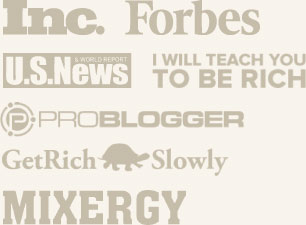What to Do When People Just Aren't Buying Your Product
 Ever get the comment “I’d love to buy your product, but I just can’t afford it”? Or–how about the even more blunt “That seems expensive!”
Ever get the comment “I’d love to buy your product, but I just can’t afford it”? Or–how about the even more blunt “That seems expensive!”
Here’s the truth: You probably don’t need to lower your price! In actuality, you can tweak your sales presentation or website by adding just a couple sentences, and that will close significantly more sales.
Read on for more details…
Why They Didn’t Buy: What Is Happening in Your Customer’s Mind?
Something I’ve probably never talked about on this blog is that I have a lot of issues with my teeth. I have big teeth and a small mouth, which has caused numerous problems over the years.
I’ve had pretty much everything done to my mouth, including several pulled teeth, retainers, a bionator, braces for 9 years, Invisalign, and five (!) gum grafts (which are major surgeries.) My teeth have been a mess ever since I was a kid, and my parents and I collectively have spent a small fortune trying to fix them.
I recently attended the Longevity Conference in Costa Mesa, CA. One of the speakers there was pretty interesting; she mentioned one of my specific problems–gum recession and regular gum grafts–as a common issue. And she said, as my dentist had mentioned, that gum grafts only last about 10 years. She claims to have found a way to cure this issue. If you follow her procedures every day, not only would you not have to have gum grafts, but you also wouldn’t have to go to the dentist all the time.
If You Don’t Set the Anchor, Someone Else Will
I was at the conference with a friend of mine, Wendi. During the talk, Wendi whispered to me that her son had a similar problem to mine and bought a Water-Pik to help his gums. It really helped clear out all the bacteria that were irritating his gums. I wondered idly how much a Water-Pik would cost, and came up with a number: $75.
In the meantime, the woman on stage was talking about a blend of essential oils that she had developed that, when put on floss, killed all the bacteria between your teeth and helped your gums out. She held the bottle up. A thought wandered through my mind: I’ve bought bottles of essential oils before that were a similar size. And the bottles cost between $8 and $16.
At the end of her presentation, I was pretty excited about the possibilities of not having to deal with gum grafts and constant dentist visits, so I got up and went to her booth to see what she was offering.
She presented me with a small pouch of various items. It included a toothbrush, a bottle of the essential oils that kill all of the bacteria, a tongue scraper, some dental floss, and a couple other miscellaneous items. She also handed me a laminated sheet of paper with bullet points describing each item.
I started the conversation being very interested in what she had to offer. But I also had a number in my head: $75. $75 just seemed “reasonable” to me for what was in the pouch.
Then I asked her how much it was. She said, “$200.”
At that point, I put the pouch and the sheet of paper down and walked away.
The Answer (It’s Not Lowering Your Price!)
From the salesperson’s perspective, this loss is a big deal. Here was someone–me!–who perfectly fit her target demographic: teeth problems; lots of surgeries; the prospect of more annoying surgeries. This kit could potentially fix all of that. It would seem, on the surface, to be a perfect fit. What happened?
You may have had this happen, too. When you meet certain potential customers, you think, “Ah, this is exactly who I envisioned would buy this product.” Yet, they don’t buy.
And you may think your answer is to lower your price. Here, I’m going to surprise you: It’s not the price itself, that mattered. You didn’t fail because your price was too high.
You failed to connect with that person because you didn’t set an anchor.
Here’s what happens. In our brains, we are constantly comparing what you have to offer with other stuff that we’ve either bought in the past or are thinking about buying. And, whether we know it or not, we have numbers in our heads of what we expect to pay.
Quick: What would you pay per month for a standard web hosting package? $8/month? $10? Yep, that’s your anchor.
How Starbucks Reset Anchors for Millions of People
What would you pay for a cup of coffee? $1.50? $3.00?
Aha–now here’s where it gets tricky. Starbucks managed to reset our anchors for a cup of coffee, didn’t they? We were all used to paying $0.99 or $1.50 or so at Dunkin’ Donuts or the local place. Suddenly, Starbucks came in, and now $3.00 (or more!) is the new normal.
How did they do that? I watched Dan Ariely’s presentation at South by Southwest, where he explained the concept of anchors and how Starbucks managed to reset our anchor for something many people drink every day–not an easy feat!
The first trick they used was to make their stores completely unlike a typical “coffee shop.” They ripped out the fluorescent lighting and piles of donuts and sold fancy pastries instead. Then, you had to learn a new lingo to order. Instead of a “small coffee”, you now order a “venti latte.”
They added comfy chairs, wi-fi, interesting music (that they then sold in the store!), and gourmet drinks like the Frappucino. The first time you walked into a Starbucks, you may have thought people were crazy to pay $3 for a cup of coffee. But, as Starbucks emphasizes, it’s not just a coffee you’re buying. You’re buying into an experience–a far more upscale experience than the Dunkin’ Donuts down the street could provide. You can feel safe meeting people and hanging out at a Starbucks, but you probably would grab a coffee and go at the other place.
Starbucks became a profit machine because they completely destroyed the anchor we had for “cup of coffee” and created a new anchor of “upscale experience”.
As a business owner, you have to understand that if you don’t create the anchor for someone, they’re going to create it themselves. In the dental hygiene workshop I attended, the speaker failed to create an anchor of “buy this or you’ll likely be subject to a $4,000 surgery, only a small portion of which will be covered by insurance.”
She set no anchor, and the anchor I had for “Water-Pik”, which my friend said had helped her son, was $75. Where did I come up with $75? No idea–but it was her lack of setting an anchor that killed the sale.
Are Anchors Rational?
Dan Ariely wrote a book called Predictably Irrational: The Hidden Forces That Shape Our Decisions–which is really a must-read for business owners. In it, he reveals an eye-opening study of setting anchors.
A professor asked students to think of the last two digits of their Social Security number. Then he asked them to bid on various items in an auction. Each person was asked to write down the last two digits of their Social Security number, plus their bid, and hand it in. The highest bidder would pay their bid and take the object home.
Here are the results:
“The students enjoyed this class exercise, but when I asked them if they felt that writing down the last two digits of their social security numbers had influenced their final bids, they quickly dismissed my suggestion. No way!
When I got back to my office, I analyzed the data. Did the digits from the social security numbers serve as anchors? Remarkably, they did: the students with the highest- ending social security digits (from 80 to 99) bid highest, while those with the lowest- ending numbers (1 to 20) bid lowest.
The top 20 percent, for instance, bid an average of $56 for the cordless keyboard; the bottom 20 percent bid an average of $16. In the end, we could see that students with social security numbers ending in the upper 20 percent placed bids that were 216 to 346 percent higher than those of the students with social security numbers ending in the lowest 20 percent.” (emphasis mine)
Do you now see how setting an anchor is important? Obviously, you don’t want to ask people to write down the last two digits of their Social Security numbers…but you can set anchors in your sales presentations.
How to Set Anchors
Here’s how I set two anchors for Guest Post Secrets:
I compared it to pay-per-click, and used the word “Imagine.” I wrote: “Imagine…thousands of targeted visitors showing up to your website, ordering your products, and sending you letters of appreciation…at no charge.
Do the math: Even at 10 cents per click (which is a pretty great rate, these days!) 4,000 visitors to your website would cost you $400. Or you can get super-targeted visitors absolutely free using this step-by-step system.
It’s your choice.”
Right there, I’ve set up a framework: This system works better than pay-per-click, and it’s not going to cost you $400 to send 4000 people to your website. In fact, this method is free.
Here’s another anchor from the same sales letter for Guest Post Secrets:
“In fact, if you called me on the phone right now and requested an hour of my time so I could teach you this, it would easily set you back more than $500…and you would have gotten more than your money’s worth! In Guest Post Secrets, you are getting three videos with a total of over 30 minutes of step-by-step content that you can play again and again…as long as you like until you are one of the Internet’s top bloggers! To think you get all this for less than the price of a single 1-hour session!”
Now I’m comparing it to an hour of my time, on which I set a value of $500.
Then the person sees that the price is just $67 (and sometimes, they have a coupon code that brings Guest Post Secrets down to $47), and the decision becomes a lot easier.
To set an anchor, compare what you’re offering to something that costs a lot more. A web design company I worked for many years ago had this text featured prominently on their website:
“The services that [company] provides allows you or your organization to utilize the ‘Information Super Highway’ at a fraction of the cost that it would take for you to do it on your own. For your organization to duplicate the services of [company], you would have to rent 6 DS3 lines ($12,000 / month), hire a systems administrator ($60,000 / year), get a programming staff ($150,000 / year), a graphic design staff ($150,000 / year), and buy the server and support hardware ($20,000). [company] has all of these items already in place and distributes the cost over many organizations while maintaining excellent performance.”
This was in 1998–and at the time, this company was one of the premier design and development organizations in my local area.
Remember: regardless of whether you’re setting the anchor or not, the anchor is being set. As the salesperson (business owner), you need to make sure you’re the one setting it. Otherwise, you will sell far less of your product–regardless of the merits of your product.
Don’t lower your price to compete with others. Focus on resetting your potential customers’ hidden anchors instead.
Recommended Reading:
- Predictably Irrational: The Hidden Forces That Shape Our Decisions. Dan Ariely–who has an amazing personal story that he shares with you in the book–takes a look at why we really buy products.
- How to Read People’s Minds (And Then Create the Product They Most Desire) Two methods by which you can (almost) read your potential customers’ minds.
- How Do All Those “Idiots” Make So Much Money? Does it drive you nuts that some idiot with a terrible product seems to be constantly making sales, when you know your product is better? What’s the difference between you and that “idiot”?


